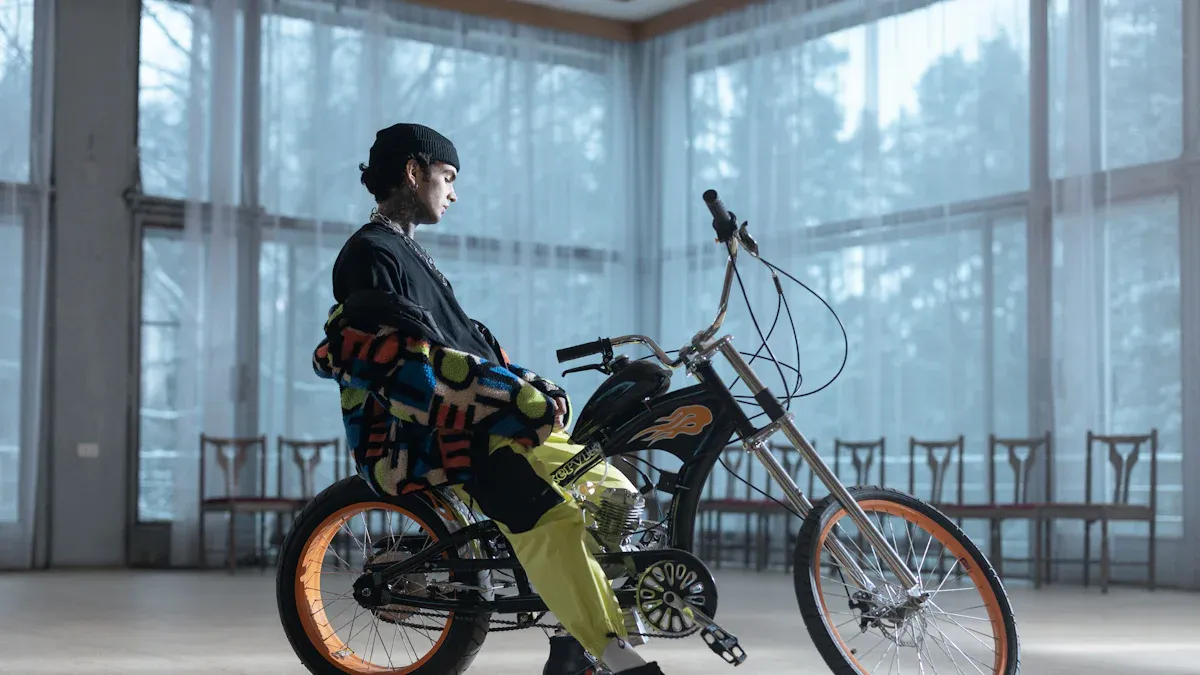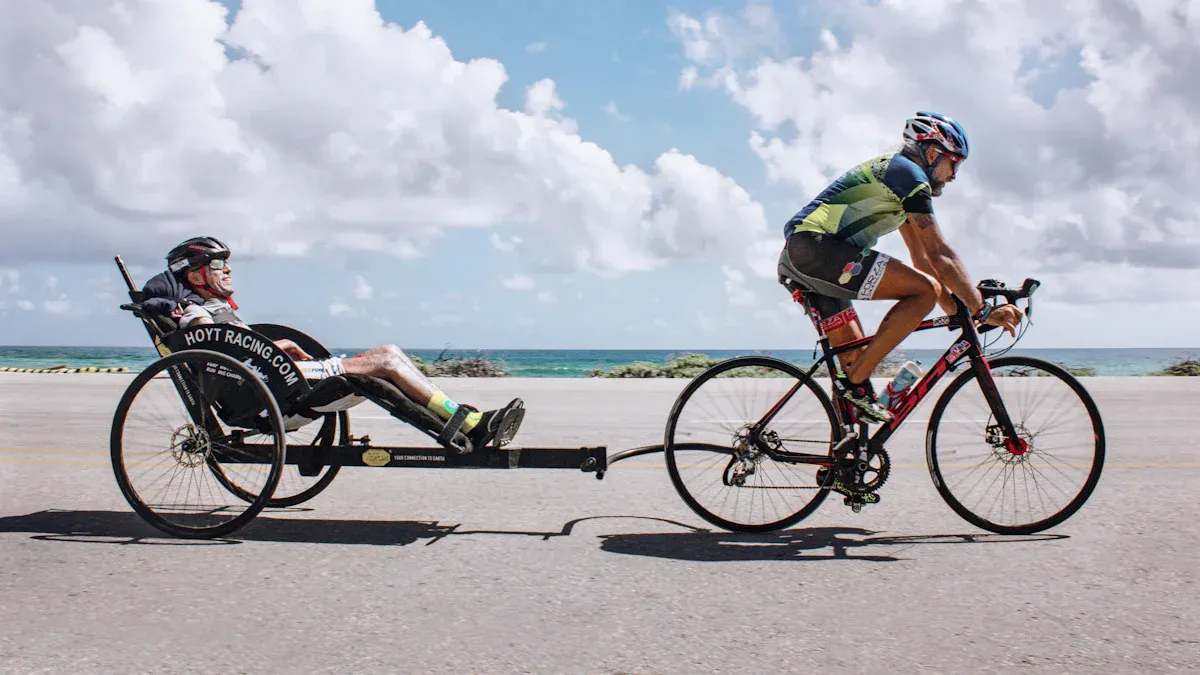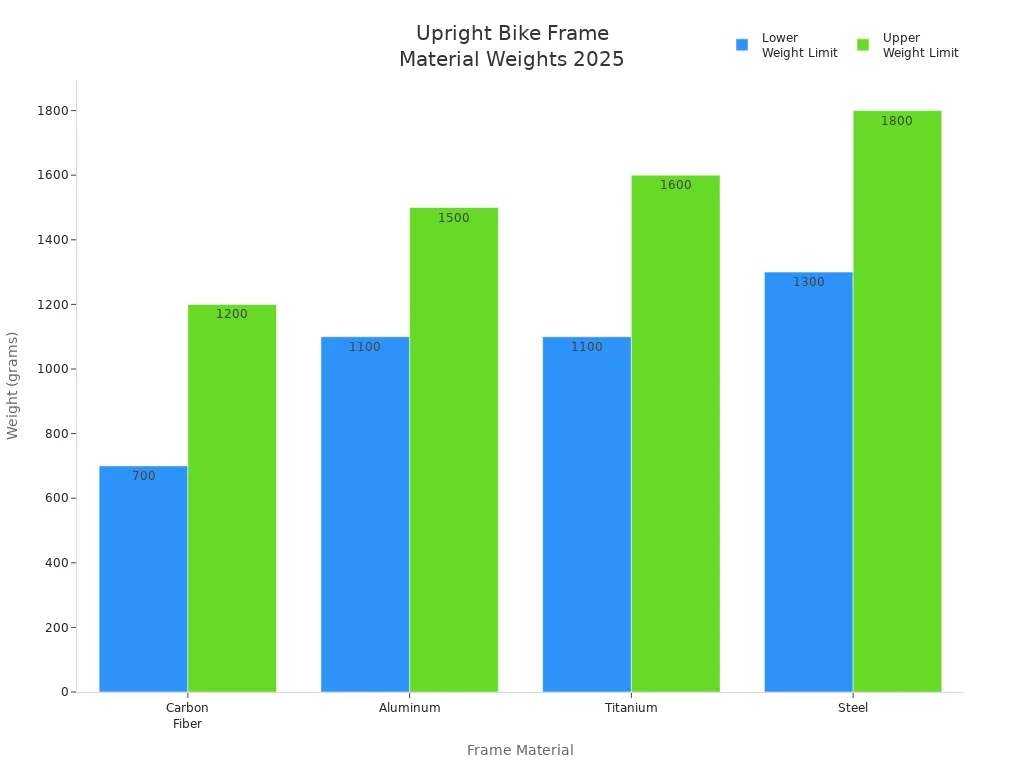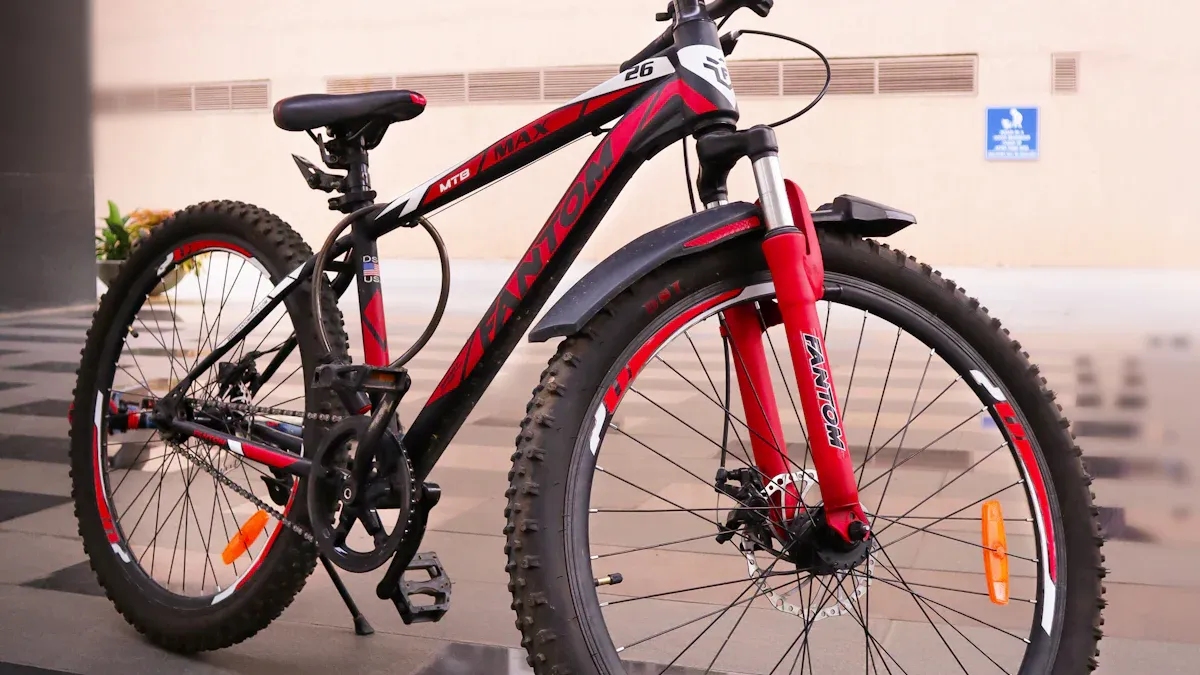
A recumbent bike frame lets you sit back in a reclined way with a comfy seat and pedals in front. This is different from a regular bike frame. The design spreads your weight over a wide, soft seat and a backrest. You feel less pressure on your spine, hips, and knees. This makes riding a recumbent bike great for comfort and joint health. New studies show a recumbent bike lowers joint strain and helps you ride longer without pain. In 2025, new designs and features make the recumbent bike even more special. See how a recumbent bike frame can change how you ride.
Key Takeaways
Recumbent bike frames give great comfort. They support your back well. They spread your weight across the seat. This lowers pressure on your joints. You can ride longer without pain.
The special frame shape helps you stay stable. The seating position makes steering easier. Recumbent bikes are safer to use. They are simple to control. Beginners and people with balance issues benefit most.
In 2025, new materials are light and eco-friendly. These materials make bikes strong but not heavy. This helps you go faster. It also helps the planet by lowering harm.
Smart technology adds fun to riding. Touchscreens let you see your stats. You can connect apps to your bike. Resistance changes by itself. You can track your fitness easily.
Recumbent bikes are good for people who want comfort. They protect your joints and give steady rides. Older adults can use them. People healing from injuries can use them. Fitness fans can enjoy longer workouts.
Recumbent Bike Frame Basics

What Is a Recumbent Bike Frame
A recumbent bike frame supports your body in a reclined position. You sit back with your legs stretched out in front of you. The seat is wide and has a backrest. This design spreads your weight across the seat and back, not just on a small saddle. You do not need to lean forward or put weight on your arms. The pedals sit in front of you, so your legs push forward instead of down.
You can find different types of recumbent bikes. Some have two wheels, while others, called recumbent trikes, have three wheels for extra stability. The frame must hold your body in a steady, comfortable way. It also needs to keep the bike balanced and easy to steer. The recumbent bike frame often uses special shapes and angles to make sure you feel safe and relaxed during your ride.
Recumbent Bicycle vs. Upright Bike
When you compare a recumbent bicycle to an upright bike, you notice big differences in how each one feels and works. The geometry of a recumbent bike frame changes the way you ride. You sit in a reclined posture, which means your weight rests fully on the seat and backrest. You do not use your arms to support your body or help with steering. This setup changes how the bike handles and how you control it.
Did you know? Recumbent bicycles use special steering geometry to keep you stable and safe. The head tube angle, fork rake, trail, and flop all work together to make steering smooth and easy.
Recumbent bikes usually have head tube angles around 70-72 degrees and fork rakes between 40-48 mm. This gives trail values of 58-70 mm and flop values of 18-22 mm.
These numbers help recumbent bikes respond to lighter, more sensitive steering inputs. You do not need to use your arms and torso to steady the bike.
Upright bikes let you use your arms and upper body to control the bike. This makes steering heavier and slower, which can feel more stable at high speeds.
Recumbent bikes use higher trail and lower flop to calm the steering and keep you steady. This helps make up for the fact that you do not use your arms and torso for balance.
The special geometry of a recumbent bicycle matches your unique riding position and weight distribution. Upright bikes use a different geometry because you sit higher and lean forward.
You also see differences in the materials used for frames. In 2025, upright bikes often use carbon fiber, aluminum, titanium, or steel. Each material has its own weight range:
Material | Typical Weight Range (grams) |
|---|---|
Carbon Fiber | 700 to 1200 |
Aluminum | 1100 to 1500 |
Titanium | 1100 to 1600 |
1300 to 1800 |

Recumbent bike frames may use similar materials, but the main difference comes from the frame shape and geometry. The recumbent bicycle focuses on comfort, stability, and aerodynamics. Upright bikes focus more on speed and quick handling. When you choose between a recumbent and an upright bike, think about what matters most to you: comfort, speed, or control.
Design Features
Frame Geometry
Recumbent bike frames have many different shapes. Some look like a Y, while others use one tube or a triangle shape. These shapes help hold your body in a comfy way. The frame shape changes how the bike rides and feels. A long wheelbase puts the front wheel behind the pedals. This makes the ride smoother and keeps the bike steady. A short wheelbase puts the front wheel in front of the pedals. This makes the bike turn faster and feel easier to steer. Recumbent trikes have three wheels for more balance. This helps if you want extra support when riding. The recumbent design puts you lower to the ground. You feel less likely to fall over. This makes recumbent bikes safer, especially for new riders.
Seating and Handlebars
The seat and handlebars on a recumbent bike change how you feel and ride. You sit back with your back flat on the backrest. Your legs stretch out in front of you. Your arms rest gently on the handlebars. Adjusting the seat stops your knees from stretching too far. It also helps your lower back feel better. The table below shows how seat changes affect comfort and safety:
Seating Position Aspect | Effect on Rider Comfort and Safety | Explanation |
|---|---|---|
Seat Adjustment (forward/backward) | Stops knees from stretching too far and helps your lower back | The right seat spot lets your knee bend a little at the end of each pedal push. This lowers joint stress and helps you pedal better. |
Backrest Position | Supports your lower back and helps you sit up straight | Keeping your back on the backrest stops back pain and slouching. This makes rides more comfy. |
Handlebar Reach | Lowers shoulder and neck pain | Handlebars in the right spot let your arms relax. This stops your upper body from getting sore. |
Foot Position | Helps you pedal better | Putting the ball of your foot on the pedal helps you pedal well and keeps your feet from hurting. |
Seat Comfort (cushioning) | Makes rides feel better | Extra padding or cushions stop numbness and make rides longer and more fun. |
Set the handlebars so your arms stay loose and a little bent. This helps you avoid pain in your shoulders and wrists. Keep your back on the seat and your hands light on the bars. This helps you sit up straight and control the bike better.
Aerodynamics and Stability
Recumbent bikes are good at cutting through the wind. The low frame and laid-back seat lower wind drag. You move through the air easier than on a regular bike. This saves energy and lets you go faster, even on long rides or windy days. The recumbent frame also keeps you steady. Being low to the ground and having a strong frame stops you from tipping over. Recumbent trikes give even more balance. This is good if you want extra safety. Many recumbent bikes have flags and mirrors to help others see you. These features make your ride safer and more fun.
2025 Innovations
Lightweight Materials
In 2025, recumbent bicycle frames use new light materials. Makers choose strong composites and recycled parts. These frames are tough but not heavy. You can ride faster and steer easier. Many brands pick recycled composites and parts that break down. This makes your bike lighter and better for the planet. The frame soaks up bumps, so your ride feels smooth. Some electric recumbent bikes use these materials. They hold batteries and motors but do not get heavy.
Smart Technology
New recumbent bicycle frames have smart tech to help you ride. Some bikes have HD touchscreens for workouts and tracking. Many connect to apps like Kinomap and Zwift with Bluetooth. You can join virtual rides and set goals. Digital screens show speed, distance, calories, and heart rate. Pulse grips on handlebars help you stay in your heart zone. Some bikes change resistance by themselves during workouts. You can save user profiles and use preset workout plans. These features make riding fun and keep you motivated.
Tip: Seats that adjust, cooling fans, and step-through frames make your recumbent bike more comfy and simple to use.
Eco-Friendly Trends
You help the earth when you pick a recumbent bike made with green ways. Companies use safe materials and eco-friendly building steps. They use less stuff than cars, so there is less pollution. New light composites lower the carbon footprint for each bike. Riding a recumbent bike does not make emissions or hurt roads much. Some bikes have IoT tools like GPS to keep you safe and track rides. These trends show you can ride and care for nature at the same time.
Recumbent vs. Traditional

Performance
You may wonder how a recumbent bike matches up to a regular bike for speed and how well it works. Recumbent bikes, especially with new MBB-FWD designs, use better aerodynamics. This helps you go faster on flat roads because the frame moves through the wind easily. The fastest bike in the world is a fully covered recumbent bike, and it can reach up to 89.95 mph. Power from your legs goes to the pedals with less wasted energy. Some recumbent bikes climb hills fast, but others might slow down, depending on their design. The table below shows how these bikes are different:
Aspect | Recumbent Bicycle (MBB-FWD) | Traditional Bike |
|---|---|---|
Aerodynamics | More aerodynamic, faster on flats | Less aerodynamic |
Top Speed | Higher (up to 89.95 mph) | Lower |
Power Transfer | Efficient, minimal loss | Standard efficiency |
Hill Climbing | Fast (MBB-FWD), slower (others) | Varies, often better than rear-drive recumbents |
Comfort & Ergonomics | More ergonomic, longer rides | Less ergonomic, more fatigue |
Comfort and Health
You will feel much more comfortable on a recumbent bike. The seat holds your back and spreads out your weight. This takes pressure off your spine, hips, and knees. You can ride longer without pain or numbness. Recumbent trikes give even more balance, which helps if you have trouble staying steady. The way you sit helps stop injuries and keeps your body in a good spot. You get a workout that is easy on your joints. Upright bikes use more muscles, like your core and arms, but they can make you sore if you ride a long time. Recumbent bikes are a great choice for people who want comfort and to protect their joints.
Tip: Move your seat and handlebars to keep your body in a healthy position and avoid getting hurt.
Who Should Choose a Recumbent
You should think about a recumbent bike if you want to be comfortable or need more support. These bikes are good for older people, anyone with back, wrist, or neck pain, and people getting better after an injury. Recumbent trikes are safer for people who have trouble with balance. People who ride for fun or to get to work like how easy and comfy they are. Fitness fans who want to ride far and steady also like them. Some people think recumbent bikes are hard to use or not safe, but experts say they are easy to see, steady, and simple to learn with practice. The good and bad things about recumbent bikes depend on what you need, but many riders say they are safer and more fun than upright bikes.
Recumbent bikes are best for people who want:
Less pain in their joints
Better support for their back
Safer and steadier rides
Bikes that are easy to fit
Longer and more comfy workouts
Recumbent bike frames in 2025 are known for comfort and stability. They have smart features that make riding better. The seat is wide and soft, with support for your lower back. You get quiet magnetic resistance when you pedal. You can connect to apps easily. These bikes fit lots of different people. They help you work out without hurting your joints. Recumbent bikes cost more than regular bikes. But you get better support and cool technology.
Take a test ride to see the difference. Many people say recumbent bikes make exercise easier and more fun. They help you build good habits that last for years.
FAQ
What makes a recumbent bike frame more comfortable than a regular bike?
You sit in a reclined position with your back supported. The seat is wide and soft. Your weight spreads out, so you feel less pressure on your spine and hips. You can ride longer without pain.
Are recumbent bikes safe for beginners?
Yes, you get more stability because you sit lower to the ground. Recumbent trikes have three wheels, so you do not tip over easily. Many new riders feel safer and more confident on these bikes.
Can you use a recumbent bike for daily commuting?
You can use a recumbent bike for commuting. Many people ride them to work or school. You get comfort and less strain on your body. Some models have space for bags or baskets.
How do you adjust a recumbent bike for your body?
Tip: Move the seat forward or backward until your knee bends slightly at the end of each pedal stroke. Adjust the backrest and handlebars so your arms and back feel relaxed. Test the fit before you start riding.
Do recumbent bikes need special maintenance?
Recumbent bikes use many of the same parts as regular bikes. You check the tires, chain, and brakes often. Some parts, like the seat or steering, may need extra care. Always follow the maker’s instructions for best results.
